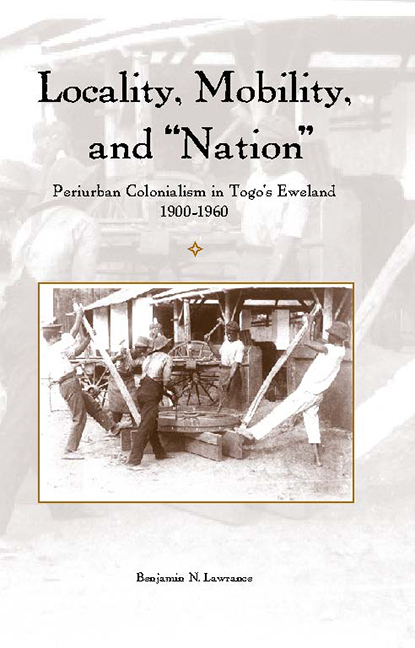Book contents
- Frontmatter
- Dedication
- Contents
- List of Illustrations
- Preface
- Notes on Orthography
- Map
- Introduction: Conceptualizing Periurban Colonialism in Sub-Saharan Africa
- 1 Mobility, Locality, and Ewe Identity in Periurban Eweland
- 2 Intervention and Dissent: Manufacturing the Model Periurban Chief
- 3 Crisis in an Ewe “Capital”: The Periurban Zone Descends on t he City
- 4 Vodou and Resistance: Politico-Religious Crises in t he Periurban Landscape
- 5 The German Togo-Bund and the Periurban Manifestations of “Nation”
- 6 From Eweland to la République Togolaise: Le Guide du Togo and the Periurban Circulation of Knowledge
- Epilogue
- Notes
- Bibliography
- Index
3 - Crisis in an Ewe “Capital”: The Periurban Zone Descends on t he City
Published online by Cambridge University Press: 11 May 2017
- Frontmatter
- Dedication
- Contents
- List of Illustrations
- Preface
- Notes on Orthography
- Map
- Introduction: Conceptualizing Periurban Colonialism in Sub-Saharan Africa
- 1 Mobility, Locality, and Ewe Identity in Periurban Eweland
- 2 Intervention and Dissent: Manufacturing the Model Periurban Chief
- 3 Crisis in an Ewe “Capital”: The Periurban Zone Descends on t he City
- 4 Vodou and Resistance: Politico-Religious Crises in t he Periurban Landscape
- 5 The German Togo-Bund and the Periurban Manifestations of “Nation”
- 6 From Eweland to la République Togolaise: Le Guide du Togo and the Periurban Circulation of Knowledge
- Epilogue
- Notes
- Bibliography
- Index
Summary
The rioters were mainly composed of the lower classes of natives, peasants from the outskirts of the town, market women, young boys … the usual thieves and bad characters.
—Vice-Consul George Howells, January 1933In 1932 the governor of French Togoland, Robert de Guise, announced an increase in taxes and the levying of new fees for Lomé market women in order to “rescue” the territory from the economic malaise caused by the worldwide depression. He similarly proposed the replacement of the municipal structure operating in Lomé since 1922 with a commune mixte. Although both the city council (the Conseil des Notables) and a relatively clandestine organization called Duawo (an Ewe word meaning “the people” from the root dou) presented petitions and voiced widespread opposition to these broad plans, warning of social unrest, de Guise continued undeterred. The Conseil saw the commune mixte as an attack on its authority; Duawo interpreted it as a step back from the cautious democratization of the 1920s; the market women saw the tax as an infringement on their right as women not to be taxed. Instead of heeding the warning, de Guise arrested two leaders of Duawo. This triggered a protest by market women from Lomé that quickly drew communities from the periurban zone into the colonial capital. Others joined this protest, which rapidly grew beyond its core of market women to a much broader employment base. It drew on deep undercurrents of economic and political frustration in the Ewe periurban zone.
These events, the “révolte des femmes” of 1933, loom large in the history of Eweland and Togo. Although the immediate circumstances are well documented, the wider context of political change between the wars remains poorly understood. Extending the analysis in chapter 2 of chieftaincy structures and political authority as envisioned within the French colonial system and moving into the urban environment of Lomé, this chapter explores the divisions of political and social power in the colonial capital and its relationship with the surrounding periurban zone.
- Type
- Chapter
- Information
- Locality, Mobility, and "Nation"Periurban Colonialism in Togo's Eweland, 1900–1960, pp. 69 - 89Publisher: Boydell & BrewerPrint publication year: 2007

